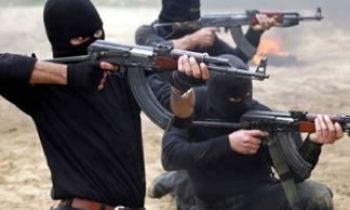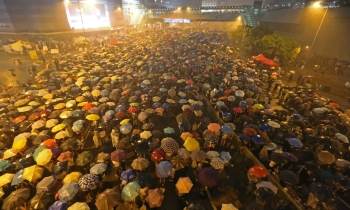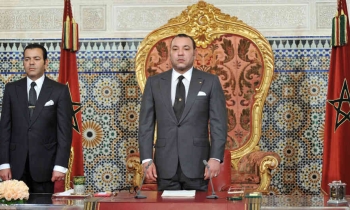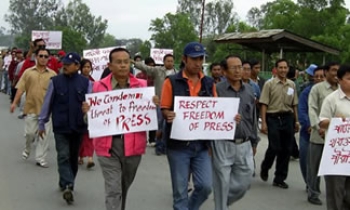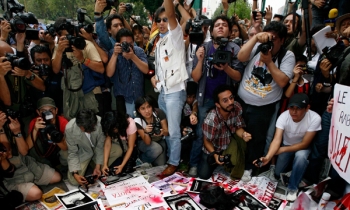Here’s a tale of two "toons." The first comprises twelve parts. They were published on September 30 of last year in Denmark’s largest newspaper Jyllands-Posten and since then have caused an intensifying crescendo of protest across Muslim communities throughout Europe and throughout the Muslim Middle East and Asia. The second appeared in The Washington Post on January 29.
The history of the first is that Danish author Kare Bluitgen had looked for an artist to illustrate a children’s book about the Muslim prophet Muhammed. None could be found.
Islam forbids artistic representation of the human form, and to represent the prophet himself is undoubtedly sacrilege for a Muslim. Still despite recent, heavy migration, most Danes are not Muslim. Why could not Bluitgen find an illustrator?
The simple answer is that artists feared for their lives. Remember when Dutch director Theo van Gogh was stabbed to death in 2004 for producing a film that depicted violence against women in Islam?
Disturbed, Iver Gundelach, president of the Danish Writers Union, protested the intimidation, and the editors of Jyllands-Posten asked forty artists to submit drawings of Muhammad. They received the 12 responses.
Muhammad is shown waving suicide bombers away from Heaven, claiming there are no more virgins; he’s shown drawing a scimitar, backed by two startled women in burkhas. They peer through the slits in their head coverings; his eyes are covered by a matching black bar. In another Muhammad is a turbaned Arab with a partial halo: its incompletion leaves him with horns. And apparently most offensive to Muslims is a portrait of the prophet wearing as a turban, a bomb with ignited fuse.
If you are wondering why the depictions have indeed caused death threats, caused armed Hamas militants in Palestine to surround European Union offices and threaten kidnappings (didn’t they just win a democratic election?), resulted in a recall of ambassadors from Denmark and the torching of Danish embassies in Damascus and Beirut, a standstill in business for Danish Aria Foods and its 1,000 employees in Saudi Arabia, Kuwait, Qatar, Bahrain and the United Arab Emirate, in warnings for European travelers, especially Danes, and in demonstrations as far spread as Asian Muslim communities, in London sporting signs such as "Be Prepared for the Real Holocaust" and "Europe, You Will Pay. Your 9/11 Is On the Way," you can view the offending works at http://face-of-muhammed.blogspot.com/
Of course seeing will probably not be believing. By secular Western standards, these cartoons run from lame to tame. In no way do they match the periodic snarling snipes to which Christians and Jews are accustomed.
Shunned by other Western media for months, the cartoons were reprinted recently in papers in Belgium, France (where the offending editor was sacked), Germany, Italy, Switzerland, Spain, Hungary, New Zealand and Jordan (editor also sacked), and shown on BBC. Reportedly, the Los Angeles Times had plans to publish them last weekend, but a web search on Sunday did not reveal they had.
Danish prime minister Andres Frogh Rasmussen has refused to censure the press: "I will never accept that respect for a religious stance leads to the curtailment of criticism, humour and satire in the press...As prime minister I have no tool whatsoever to take actions against the media, and I don’t want that kind of tool (www.frontpagemag.com)."
Oddly our own State Department waffled: "We all fully recognize and respect freedom of the press and expression, but it must be coupled with press responsibility," said a spokesman, adding "inciting religious or ethnic hatreds in this manner is unacceptable." Of course that doesn’t say "don’t publish," but who has? Often nettlesome CNN announced "CNN has chosen to not show the cartoons out of respect for Islam."
Now I’m wondering who it is that "don’t get no respect"? Anti-Israeli (Jewish) cartoons are commonplace throughout Europe. In New York last weekend, the National Black Fine Art Show included a painting by Harlem artist "Tafa," who depicted Jesus with the face of Osama Bin Laden ("no accident," he said) and bordered the work with tags of "mujahadin," "McCarthyism," and "Amadou Diallo (killed by NYC police in 1999)" I’m not sure what all that means, but I suspect it’s profane.
The second cartoon in this tale was drawn by Pulitzer Prize winner Tom Toles and
appeared in The Washington Post. A heavily bandaged quadriplegic lies in a hospital bed (with a medical chart labeled U.S. Army’) attended by a doctor (Defense Secretary Donald Rumsfeld) who is saying "I’m listing your condition as battle hardened.’ I’m prescribing that you be stretched thin. We don’t define that as torture."
On February 2, the Joint Chiefs of Staff responded with an unusual letter complaining that "[u]sing the likeness of a service member who has lost his arms and legs in war as the central theme of a cartoon is beyond tasteless. Editorial cartoons are often designed to exaggerate issues-and your paper is obviously free to address any topic, including the state of readiness of today’s Armed Forces. However, we believe you and Mr. Toles have done a disservice to your readers and your paper’s reputation by using such a callous depiction of those who have volunteered to defend this nation, and as a result, have suffered traumatic and life-altering wounds..."
The letter appeared not to have ruffled feathers at the Post nor with Toles, who said he did not regret his drawing, but felt the Joint Chiefs’ interpretation was a little "unfair." However, commentator Les Payne, writing in Long Island’s Newsday last Sunday, was strident: "The men who command the armed forces of the world’s lone superpower attacked a cartoonist who used his pen to depict their boss in a negative light in his newspaper."
Continuing sarcastically in the rhetorical vein of militant Islam, Payne declared "This infidel cartoonist...rendered a graven image of Secretary of Defense Donald Rumsfeld. It has long been accepted in the media that this infallible messenger of Bush-Cheny - known among the faithful as Prophet Rumsfeld - should be portrayed only in a light most positive." Payne ends with advice for the American people to protect "infidel Toles and the press he represents."
Well, I agree even though I suspect Toles is in neither physical danger nor in danger of losing his job. I just wonder why Payne had nothing to say about the response of the worldview he simulates to the cartoons in Jyllands-Posten.
But I wonder even more why the American media, across the board, has not demonstrated by publishing the offending cartoons that our press is not bound by Muslim religious law.
In commentary on Netherlands Radio, Michel Hoebink declared "ridicule won’t lead to dialogue," noting the extreme nature of Muslim response has been far removed from dialogue.
On the other hand, lone voices are heard. Mona Eltahawy is a New York based Egyptian commentator who writes for both the Arab and Western press. In a column written in English for Lebanon’s The Daily Star and in Arabic for Egypt’s al-Dostour, she pointed to a basic tenet of free speech: "However offensive any of the 12 cartoons were, they did not incite violence against Muslims." In fact, she went on, "in August, the Danish authorities withdrew for three months the broadcasting license of a Copenhagen radio station after it called for the extermination of Muslims. Those were real threats, and the government protected Muslims - the same government later condemned for not punishing the newspaper that published the cartoons."
Eltahawy continued, "While right-wing anti-immigration groups whip up Islamophobia in Denmark, Muslim communities wallow in denial over the increasing role of their own extremists...Muslims must honestly examine why there is such a huge gap between the way we imagine Islam and our prophet, and the way both are seen by others."
These are courageous words and the right words. It’s dishonest to demand or give phony respect to postures that deliberately undermine the basic foundation of free society, which is free thought and the ability to express it.

